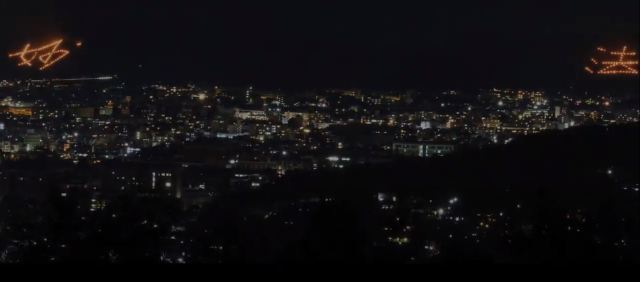
Gozan no Okuribi organizers strike a balance between tradition and safety.
Every year in August, during the Obon season in Japan, Kyoto holds the Gozan no Okuribi event in which gigantic shapes are created in fire on cleared areas of five mountains. The name “okuribi” means “send-off fire” as it’s meant to wish farewell to the spirits of ancestors who visited during Obon.
Having watched that video you may have spotted many instances of crowds gathering to either create the elaborate fires or simply watch them from afar. It’s a big draw, and last year some 28,000 people were said to have viewed the Gozan no Okuribi.
However, in the year of COVID-19 that just won’t do, and a cancellation was seriously considered for the first time since World War II. This is a decision not taken lightly by the organizers who consist of local families who have passed down this tradition throughout generations.
To make matters worse, no one can really say how long the effects of this pandemic will carry on for. The longer this tradition is pushed aside for the sake of social distancing, the more at risk of disappearing forever it becomes.
So, in order to keep the okuribi alive and also prevent large groups of people from congregating, the families behind it believe they have found an elegant solution: They’re going to make it suck.
https://www.youtube.com/watch?v=jAwKbaVAGZI
I mean that in the best possibly way though. It’s actually quite clever, in that they are drastically reducing the number of fires in each of the five designs so that they are as underwhelming as possible while still being somewhat unique and, more importantly, still burning.
The centerpiece of the Gozan no Okuribi is the Daimonji, a kanji character for “big” which is lit first and consists of 75 separate bonfires.
This year, however, only six of those fires will be lit.
▼ Computer simulation
A few minutes later the Myo and Ho kanji characters that express Buddhism ideology are lit, but this year will be reduced from 166 fires to two.
▼ Computer simulation
Next up is the self-explanatory Funagata or “Boat Shape” which is getting knocked down to a single fire from it’s original 79.
▼ Computer simulation
The Daimonji fire is so nice that they do it twice, but instead of the 53 fires that go into the Hidari Daimonji, there will now be one.
▼ Computer simulation
Finally the Toriigata representing the gates in front of Shinto shrines usually has the most fires for a single shape at 108.
In 2020 though, it will only have two.
▼ Computer simulation
“Festive” certainly isn’t the word I’d use for these new designs, but drastic times call for drastically reduced fires. Others in Japan also expressed their disappointment in the news, but also took the opportunity to remember its true meaning.
“It’s unavoidable…”
“I wonder if they’ll still broadcast these dots on TV.”
“I think they should do it as usual out of respect for the dead.”
“On the bright side it’s a good test of your imagination.”
“I thought I was reading a satirical news site at first.”
“It’s like looking at constellations.”
“People forget that it’s a ritual, not a spectacle. It’s more important that they carry on than make a show for the rest of us.”
The organizers also mentioned that honoring those who had succumbed to COVID-19 was a part of the motivation to carry on the tradition in a reduced form.
There is still a possibility that this might backfire and people will head out into the most popular lookout spots to get a picture of this rare configuration of fires anyway. But the organizers did a pretty good job at making these new arrangements look incredibly boring. So they might end up being effective at significantly cutting down on the lookie-loos who will opt for the more beautiful tofu version instead.
Source: Kyoto Shimbun, My Game News Flash
Images: YouTube/S.ENDO
Computer simulations ©SoraNews24
● Want to hear about SoraNews24’s latest articles as soon as they’re published? Follow us on Facebook and Twitter!











 Organizers angered as ceremonial giant kanji “fire” in Kyoto lit early and unofficially
Organizers angered as ceremonial giant kanji “fire” in Kyoto lit early and unofficially Kyoto-roasted coffee has a connection to one of the city oldest, most beautiful summer ceremonies
Kyoto-roasted coffee has a connection to one of the city oldest, most beautiful summer ceremonies Five things you need to know about Obon–one of Japan’s biggest holidays 【Videos & more】
Five things you need to know about Obon–one of Japan’s biggest holidays 【Videos & more】 Japanese beef bowl chain Sukiya’s 2026 Smile Box lucky bag basically pays for itself
Japanese beef bowl chain Sukiya’s 2026 Smile Box lucky bag basically pays for itself New Japanese menstrual product seeks to help women spot unidentified iron deficiencies
New Japanese menstrual product seeks to help women spot unidentified iron deficiencies Play games, learn, and get your fortune at Ginza’s limited-time Tsunaguu “Shrine of the Future”
Play games, learn, and get your fortune at Ginza’s limited-time Tsunaguu “Shrine of the Future” Starbucks Japan ready to get Year of the Horse started with adorable drinkware and plushies【Pics】
Starbucks Japan ready to get Year of the Horse started with adorable drinkware and plushies【Pics】 7-Eleven Japan has a hack for creating insanely delicious potato chip rice meals
7-Eleven Japan has a hack for creating insanely delicious potato chip rice meals Busty Japanese brushstroke calligraphy artist shares visual appeal in video series【Videos】
Busty Japanese brushstroke calligraphy artist shares visual appeal in video series【Videos】 Pizza Hut Japan’s hot lucky bags are perfect for a New Year’s pizza party
Pizza Hut Japan’s hot lucky bags are perfect for a New Year’s pizza party 8 sakura sweets to enjoy under the cherry blossoms at your next hanami picnic in Japan
8 sakura sweets to enjoy under the cherry blossoms at your next hanami picnic in Japan Is real Tokyo as dangerous as the Yakuza video games? Chapter 3: Crazy Town
Is real Tokyo as dangerous as the Yakuza video games? Chapter 3: Crazy Town Get ready for a cherry-blossom-flavored spring with Sakura Butter potato chips from Calbee!
Get ready for a cherry-blossom-flavored spring with Sakura Butter potato chips from Calbee! 7 great places to see Mt. Fuji from without having to climb it
7 great places to see Mt. Fuji from without having to climb it Cyberpunk anime meets traditional culture in Ghost in the Shell gold leaf Japanese changing screens
Cyberpunk anime meets traditional culture in Ghost in the Shell gold leaf Japanese changing screens Hayao Miyazaki says Happy New Year to Studio Ghibli fans with new art for Year of the Horse
Hayao Miyazaki says Happy New Year to Studio Ghibli fans with new art for Year of the Horse Hello Kitty Choco Egg figures are an adorable trip through three periods of Japanese pop culture【Pics】
Hello Kitty Choco Egg figures are an adorable trip through three periods of Japanese pop culture【Pics】 We found possibly the quietest Japanese-style hotel in Tokyo’s bustling Shinjuku district
We found possibly the quietest Japanese-style hotel in Tokyo’s bustling Shinjuku district 7-Eleven Japan’s ramen-cooking robot whipped us up a bowl of noodles【Taste test】
7-Eleven Japan’s ramen-cooking robot whipped us up a bowl of noodles【Taste test】 Sumo Sanrio! Hello Kitty and pals team up with Japan Sumo Association for new merch【Pics】
Sumo Sanrio! Hello Kitty and pals team up with Japan Sumo Association for new merch【Pics】 Japan’s oldest largetooth sawfish in captivity back on display in Mie Prefecture
Japan’s oldest largetooth sawfish in captivity back on display in Mie Prefecture More Than a Capsule Stay: Why Solo Travelers Choose “global cabin Yokohama Chinatown”
More Than a Capsule Stay: Why Solo Travelers Choose “global cabin Yokohama Chinatown” 7-Eleven Japan starts new temporary luggage storage service in over 300 branches
7-Eleven Japan starts new temporary luggage storage service in over 300 branches Disillusionment at Tsukiji’s tourist-target prices led us to a great ramen restaurant in Tokyo
Disillusionment at Tsukiji’s tourist-target prices led us to a great ramen restaurant in Tokyo Starbucks teams up with 166-year-old Kyoto doll maker for Year of the Horse decorations【Photos】
Starbucks teams up with 166-year-old Kyoto doll maker for Year of the Horse decorations【Photos】 Tokyo considering law requiring more trash cans following litter increase in heavily touristed area
Tokyo considering law requiring more trash cans following litter increase in heavily touristed area Tokyo’s Tsukiji sushi neighborhood asks tour groups to stay away for the rest of the month
Tokyo’s Tsukiji sushi neighborhood asks tour groups to stay away for the rest of the month Tokyo event lets you travel back in time, for free, to celebrate 100 years since Showa era start
Tokyo event lets you travel back in time, for free, to celebrate 100 years since Showa era start Sanrio theme park in Japan announces plans to expand into a Sanrio resort
Sanrio theme park in Japan announces plans to expand into a Sanrio resort Japan may add Japanese language proficiency, lifestyle classes to permanent foreign resident requirements
Japan may add Japanese language proficiency, lifestyle classes to permanent foreign resident requirements Stamina-destroying “Paralysis Noodles” are Tokyo’s newest over-the-top ramen innovation
Stamina-destroying “Paralysis Noodles” are Tokyo’s newest over-the-top ramen innovation Survey asks foreign tourists what bothered them in Japan, more than half gave same answer
Survey asks foreign tourists what bothered them in Japan, more than half gave same answer Japan’s human washing machines will go on sale to general public, demos to be held in Tokyo
Japan’s human washing machines will go on sale to general public, demos to be held in Tokyo Japan’s deadliest food claims more victims, but why do people keep eating it for New Year’s?
Japan’s deadliest food claims more victims, but why do people keep eating it for New Year’s? We deeply regret going into this tunnel on our walk in the mountains of Japan
We deeply regret going into this tunnel on our walk in the mountains of Japan Studio Ghibli releases Kodama forest spirits from Princess Mononoke to light up your home
Studio Ghibli releases Kodama forest spirits from Princess Mononoke to light up your home Major Japanese hotel chain says reservations via overseas booking sites may not be valid
Major Japanese hotel chain says reservations via overseas booking sites may not be valid Put sesame oil in your coffee? Japanese maker says it’s the best way to start your day【Taste test】
Put sesame oil in your coffee? Japanese maker says it’s the best way to start your day【Taste test】 No more using real katana for tourism activities, Japan’s National Police Agency says
No more using real katana for tourism activities, Japan’s National Police Agency says Starbucks Japan reveals new sakura drinkware collection, inspired by evening cherry blossoms
Starbucks Japan reveals new sakura drinkware collection, inspired by evening cherry blossoms Updated cherry blossom forecast shows extra-long sakura season for Japan this year
Updated cherry blossom forecast shows extra-long sakura season for Japan this year
Leave a Reply